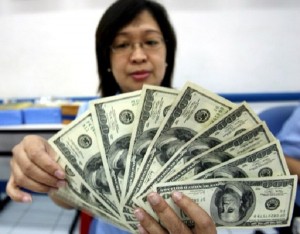Forex reserves hit new high of $76.3B

NEW HIGH A bank employee counts 100 US dollar notes in Manila in this file photo. The Philippines’ foreign exchange reserves grew further in November to hit a new high of $76.3 billion, the central bank said. AFP PHOTO/TED ALJBE
The country’s foreign exchange reserves grew further in November to hit a new high of $76.3 billion in what the central bank said should help boost the chances of the Philippines to get another credit-rating upgrade in 2012.
The latest gross international reserves (GIR) level was higher than the previous month’s $75.83 billion and the $60.56 billion posted in November last year.
“The increase in the reserves stemmed from the income from investments abroad and foreign exchange operations of the BSP,” the Bangko Sentral ng Pilipinas said in a statement.
It added that the increase in the price of gold in the world market also helped boost the country’s reserves, of which $8 billion was in the form of gold.
The BSP invests a portion of the country’s GIR in virtually risk-free instruments like US treasuries. Earnings from the central bank’s securities investments add to the overall reserves.
Article continues after this advertisementMeantime, the central bank has foreign exchange operations under which it buys and sells currencies with the intention of helping temper a sharp rise or fall of the peso against the greenback. It buys dollars, a move that increases the GIR, if there is too much foreign exchange inflow that can push the local currency significantly higher.
Article continues after this advertisementThe BSP said it has a policy of allowing a market-determined exchange rate, but added that it buys or sells currencies from time to time to prevent volatility in the exchange rate. A sharp and sudden appreciation or depreciation of the local currency is disruptive to business and to the overall economy.
Major contributors to the GIR have been the continually rising remittances from Filipinos based abroad, foreign portfolio investments and investments in the business process outsourcing industry.
Monetary officials said the country’s rising reserves indicated an improving ability to settle maturing foreign debts as well as pay for imported goods. Officials said this backdrop should improve the country’s creditworthiness and lift its credit rating.
According to the BSP, the latest GIR was enough to cover 11.2 months’ worth of imports and was 6.5 times the country’s debts maturing within a year.
The Philippines is rated two notches below investment grade by Moody’s Investors Service and Standard & Poor’s and a notch lower by Fitch Ratings.